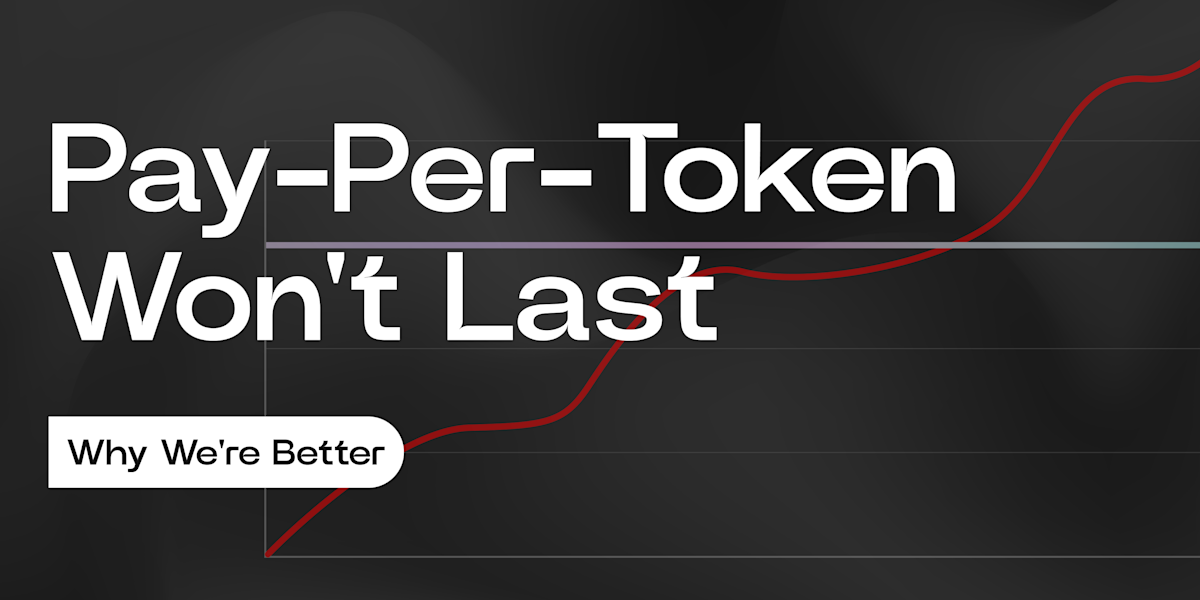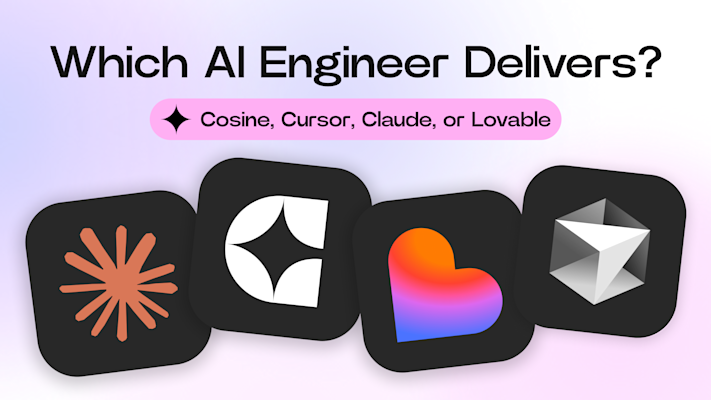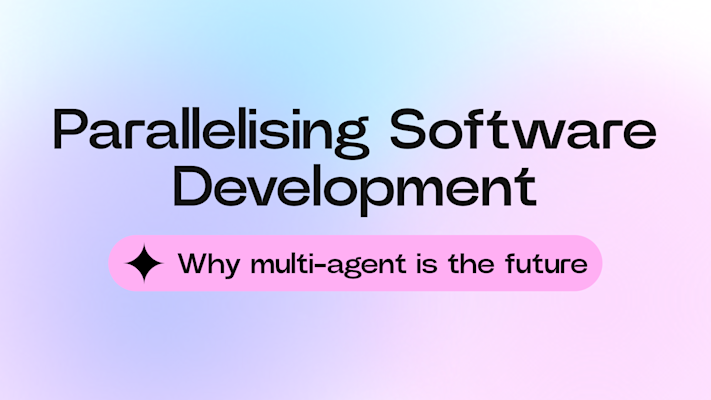AI-coding assistants are becoming increasingly commonplace, but how people pay for them varies widely. Most tools like Cursor, Windsurf, and Devin use a pay-per-token model, where every prompt or character comes with a price.
Cosine’s Genie flips the script with a monthly pay-by-task model.
Why does this matter? Pricing models shape cost predictability, transparency, and how you actually use the tool. Here’s how they compare – and why our approach is gaining traction as more aligned with real user outcomes.
How Pay-Per-Token Models Work
Pay-per-token pricing ties cost directly to how much the AI is used, typically measured in tokens (small word fragments) or similar compute units. Most coding assistants using this model offer monthly plans with usage caps, charging extra if you exceed your quota or pushing you to a higher tier.
Take Cursor, an AI-powered code editor. Its Pro plan costs around $20/month per user and includes a usage allowance based on model inference costs. As their FAQ explains, the plan covers “at least $20 of agent model inference at API prices.” Go beyond that, and you’ll hit limits or be prompted to upgrade.
In short, you’re buying a usage chunk, not true unlimited access. Power users can upgrade to plans like Cursor Ultra ($200/month) for higher limits. While the pricing looks like a flat subscription, it’s ultimately tied to how many tokens you burn – use more, pay more.
Codeium’s Windsurf follows a similar usage-based model, starting at around $15 per seat, positioning itself as a lower-cost alternative to Cursor. But instead of tokens, Windsurf uses “premium model credits,” split into User Prompt and Flow Action credits. For example, the Pro plan includes 500 prompt credits and 1,500 action credits per month.
Each AI interaction – whether asking a question or having the agent run a command – draws from these credit pools. If you run out, you can buy more (e.g. $10 for 300 additional credits). While these credits abstract away raw token counts, they still reflect underlying compute usage.
Cognition’s Devin launched with a $500/month team plan, bundling a large amount of usage. Its pricing is based on Agent Compute Units (ACUs), where 1 ACU roughly equals 15 minutes of AI work. Early plans offered around 250 ACUs, but Cognition later introduced a $20/month tier with about 9 ACUs, shifting to a pay-as-you-go model.
In practice, more complex tasks consume more ACUs, meaning higher cost. While framed around compute time, Devin’s model is effectively usage-based, similar to token or API billing.
Most AI dev tools follow a familiar pattern: free tiers or trials with limited usage, then paid plans that scale with how much AI compute you use. But overall, the broader trend is clear: pricing is increasingly tied to what costs companies money – AI model compute. An efficient solution for vendors covering GPU costs, but for users, it introduces complexity and unpredictability.
Cosine’s Monthly Pay-By-Task Model
We take a different approach with our AI engineer, Genie.
Instead of charging by tokens or usage, users pay a flat monthly rate. That means the cost is based on outcomes, like fixing a bug or implementing a feature, not on how much compute or time the AI uses.
How it works:
Assign a coding task (e.g. “Fix crash on Save”) from tools like Jira or Linear. Genie plans, codes, iterates, and opens a GitHub pull request. You’re billed a fixed price every month. Yes, it’s that simple.
Predictable pricing: You pay per task, not per prompt or token. No surprise overages.
Aligned incentives: We only succeed when your task is completed – wasted compute is our problem, not yours.
Outcome-focused: You’re paying for shipped features, not abstract usage metrics.
Less stress: No tracking token meters or worrying about retries – just delegate and wait for delivery.
Our pricing principle is simple: you pay for what gets done. It’s a user-first model that puts results and trust at the centre.
How Pricing Affects Users In Practice
Let’s go through some real-world scenarios to see how these different pricing models work.
Adding a New Feature – Analytics Dashboard
With a pay-per-token AI:
Alice wants to generate a React analytics dashboard with charts and date filtering. She writes a prompt in her IDE. The assistant pulls in context, reads code, and generates several hundred lines. Each response, and every follow-up prompt to fix bugs or tweak styling, eats into her token quota.
If the AI’s output is off or incomplete, Alice may burn through thousands of tokens (maybe 50K or more), costing a significant chunk of her monthly plan. She starts second-guessing whether to refine with the AI or just fix it herself. Cost uncertainty discourages iteration.
With Cosine’s Genie:
Alice assigns the “analytics dashboard” task to Genie. Genie analyses her codebase, experiments, debugs, and submits a polished pull request. Alice requests a small tweak, Genie updates it, and the task is done.
She doesn’t worry about tokens, retries, or runtime. Whether Genie used 10K or 100K tokens is irrelevant – the price stays the same. Alice pays for the result, not the process. It’s a clear, predictable trade-off: one feature delivered, one price paid.
Debugging a Tricky Crash
With a pay-per-token AI:
Bob is chasing down an intermittent crash: it only happens after a user edits their email, and the app has been running for over an hour. He describes the issue to the AI, which then scans multiple files, suggests theories, and requests logs. Every step – code reads, log analysis, static checks – burns tokens.
As the debugging session grows, so does his usage. Bob starts rationing input to avoid hitting limits: shorter logs, narrower code scopes, fewer follow-ups. He’s managing cost instead of letting the AI go deep. If he hits a cap mid-investigation, progress stalls until he upgrades or switches tools.
With Cosine’s Geni:
Bob files the bug as a task: “Fix crash on profile save after 1h runtime.” Genie takes over, running the app in a sandbox, analysing logs, testing edge cases, and tracing the issue – no need for Bob to micromanage. After a thorough investigation, Genie identifies the bug (a null pointer in cache logic), fixes it, and submits a pull request.
Bob pays a flat fee, regardless of whether Genie used 10K or 100K tokens on the journey to task completion. He didn’t worry about costs mid-debug, and Genie was incentivised to solve the issue efficiently. Bob’s only focus was: Is the bug gone? (Yes.)
Why This Shift Matters
We don’t like to view Genie as simply an AI assistant. Instead, we view our coding agent as a true collaborator. And when people bring on a teammate, they don’t want to pay by the minute – they pay for results.
Builds Trust Through Predictability: Fixed pricing removes fear of surprise bills, making teams more comfortable using AI regularly and for real work.
Focuses on Outcomes, Not Usage: You pay for completed tasks, not tokens, making ROI clear and easy to justify to stakeholders.
Unlocks Bigger, Harder Tasks: Without penalties for effort, users delegate tougher problems.
Sets a New Pricing Standard: As AI tools mature, value-based models (like per-task) offer sustainable, user-friendly alternatives to usage-based billing.
Keeps AI Human-Centred: Pricing by results reinforces that AI exists to solve problems, not to drain budgets. It aligns tech with human goals.
Cosine’s pay-by-task model points to a more customer-aligned future for AI tools – one where cost is tied to outcomes, not usage. It removes friction, builds trust, and lets developers focus on delivering real results.
The goal isn’t just cost savings, it’s enabling a deeper, more effective collaboration between humans and AI, all in service of shipping reliable software faster.


 @PandelisZ
@PandelisZ 

